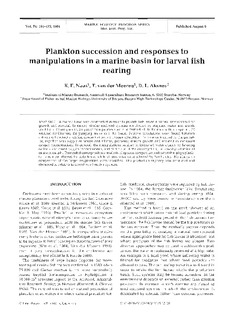| dc.description.abstract | A marine basin was constructed in order to provide fish larvae a natural environment for growth and survival. In nature, similar enclosed systems are limited by stagnant water and anoxic conditions. Consequently, 3 types of manipulations were performed: (1) turbulence with a propeller; (2) artificial fertilization; (3) pumping water into the basin. Positive correlations were found between chlorophyll content a, diatom concentration and oxygen saturation. Turbulence induced by the propeller, together with supply of nitrate and silicate, promoted diatom growth and resulted in increased oxygen concentrations. In general, the manipulations resulted in improved water quality by favoring diatoms, increased oxygen concentrations, and at the end of the investigation, increased production of calanoid nauplii. Detrended correspondence analysis of species composition indicated that phytoplankton was most affected by turbulence, while ciliates were most affected by fertilization. No effects on composition of the larger zooplankton were identified. The production capacity was estimated and discussed in relation to closed vs advective systems. | en |
